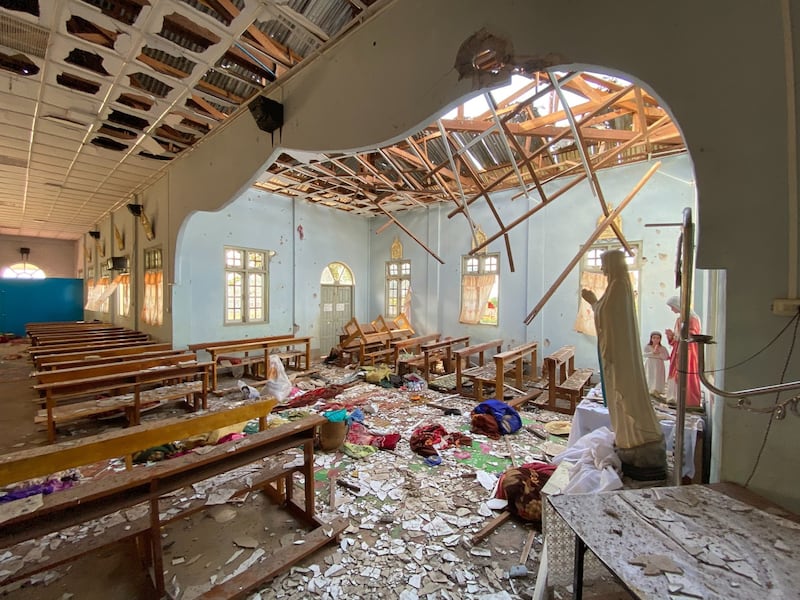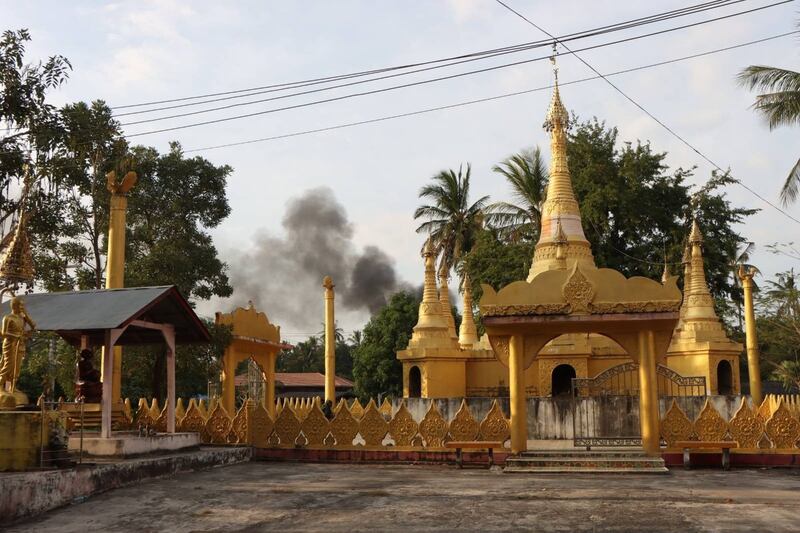In Myanmar, junta troops aren’t just terrorizing villages and committing atrocities – they’re looting and destroying historical sites and cultural artifacts, villagers say.
Ever since soldiers set fire to scores of houses and church buildings in Thantlang, in the northern Chin region, in late 2021 and early 2022, they’ve been raiding homes to steal jewelry, shaman ropes, handwoven bags and drums, said Yaw Maung, from the civilian administration office in Mindat that’s linked to the anti-junta opposition.
“Soldiers knew they were significant and precious,” he said.
Wildlife preserves and national parks are also being destroyed as a result of the fighting.
Nationwide, over 132 religious buildings have been destroyed by arson and gunfire, and others have been looted and designated construction projects by the regime. The pace of destruction has increased this year, residents say.
The looting and destruction appears to be part of military efforts to break the spirits of locals, terrorize areas with strong resistance forces and destroy ethnic culture. In the midst of the junta’s land grabbing in liberated areas, valuable sites are among the hardest hit.
As culturally significant areas around the country face damage from gunfire, airstrikes and raids, the shadow National Unity Government – made up of former political leaders ousted by the military in the 2021 coup and other opponents – has taken measures to designate them as heritage sites.
Protecting treasures
Toward that end, the NUG established the Interim Board for Heritage Administration last June. It has coordinated with consultative councils, resistance groups and People’s Administrative offices across Chin, Sagaing, Magway and Kayah States to try to protect these areas. Some strategies include PDF groups driving fighting away from these sites, guarding historical monuments and educating these local administration offices on conservation techniques.
So far, the board has designated 59 heritage sites across Magway and Sagaing regions, including already recognized UNESCO sites like Hanlin and the Pyu archeological site of Beikthano, as well as others, like pagodas and schools. The board says that they have proposed around 100, though.

Hanlin, a village and archeological site with UNESCO recognition, was among the first to be designated as a protected heritage site in late 2022. But in January, 100 soldiers based in the ancient Pyu village set fire to one monastery and 50 houses the neighboring Kan Gyi Taw village.
“This is a war crime,” Interim Board for Heritage Administration spokesperson Soe Thura Tun said. “It’s against the Geneva Convention and other conventions our government signed.”
Since the coup, Hanlin has been subjected to several types of culture destruction, including the torching of villages and the theft of artifacts. Despite being listed under the board’s recognized sites, the area has remained a battleground.
“We don’t have enough forces for things like [full-time protection]. It’s our problem until now. Even in Hanlin, they attack it frequently. Our resistance forces try to protect it, but it’s not successful every time,” Soe Thura Tun said.
Threatening wildlife
The fighting and disruptions have taken a toll on wildlife habitats as well.
Mount Victoria, a sprawling national park located in northern Chin State, was lauded by both ASEAN and UNESCO for its biodiversity and decade-long conservation.
But as the Burma Army attacked surrounding villages, displaced people and villages within the park have taken a toll as they’ve needed to supplement their livelihood. This has threatened the wildlife the state had worked for a decade to preserve, Yaw Maung said.
Yaw Maung said he’s heard reports of people killing up to 200 birds a day, hunting large bears and other endangered animals in the park. He says the farmland has expanded into the park by 10 hectares (1,000 acres) and rampant timber trade also threatens the area.
“It’s headed for something way worse because of the war that’s going on– everybody is fighting for survival,” said.

In the northern region of Sagaing, similar concerns are surfacing.
One of the hardest-hit areas is Alaungdaw Kathapa National Park, where illegal logging is shrinking forest land, according to satellite images, said Henry, an expert for the heritage board and as a technical advisor for the opposition Nation Unity Government’s Ministry of Natural Resources and Environmental Conservation.
While educating people’s administrative offices on how to best preserve these regions, he says reports of complications on the ground continue to surface, including airstrikes, security while monitoring the areas and working with people’s defense forces that are not under the National Unity Government.
“There is so much damage to the natural heritage sites compared with the cultural heritage sites,” he said, requesting to use a pseudonym to protect his identity.
“In some areas, it’s very remote, so it’s very difficult to control and reach the resources. So those kinds of limitations are always heard from the local administrative bodies. They report so many challenges.”
Seeking refuge
Civilians often seek shelter in places that hold cultural and historical significance, believing that they would be safe from attack there, Soe Thura Tun said.
“They like to stay in such kinds of places because they will be protected. People do not like to attack such kinds of areas, pagodas, churches, everything. he said. “It’s simple. We’re anxious for our people.”
Administrators and advocacy groups report these attacks are on the rise. In Karenni State, four church buildings were burned in 2021, killing four villagers who were sheltering in one.
Over 2022, the number of damaged and destroyed churches rose from 12 to 36, with attacks on Buddhist temples also growing, according to Banyar, director of the Karenni Human Rights Group.
“This is part of the strategy of the junta. When they approach the area, they went to three particular areas. The first area is the temple or church,” he said.
He added the military takes these, along with schools and community centers, as bases because they’re often centrally located in the town with a fence and strategic vantage points. “The troops take those buildings mainly by force, so they’re shelling those areas first.”
For many, the concern with fading culture and heritage is intertwined with the loss of livelihood and increased demands of international humanitarian assistance. Both UNESCO and the Myanmar Archeology Association declined to comment, citing a lack of ongoing cultural projects in the country.
“These kinds of ethnic cultures are not being documented, not being recorded, not being encouraged, not being preserved,” Yaw Maung said. “Then they are just evaporating into oblivion, like they never existed.”
Edited by Malcolm Foster.
